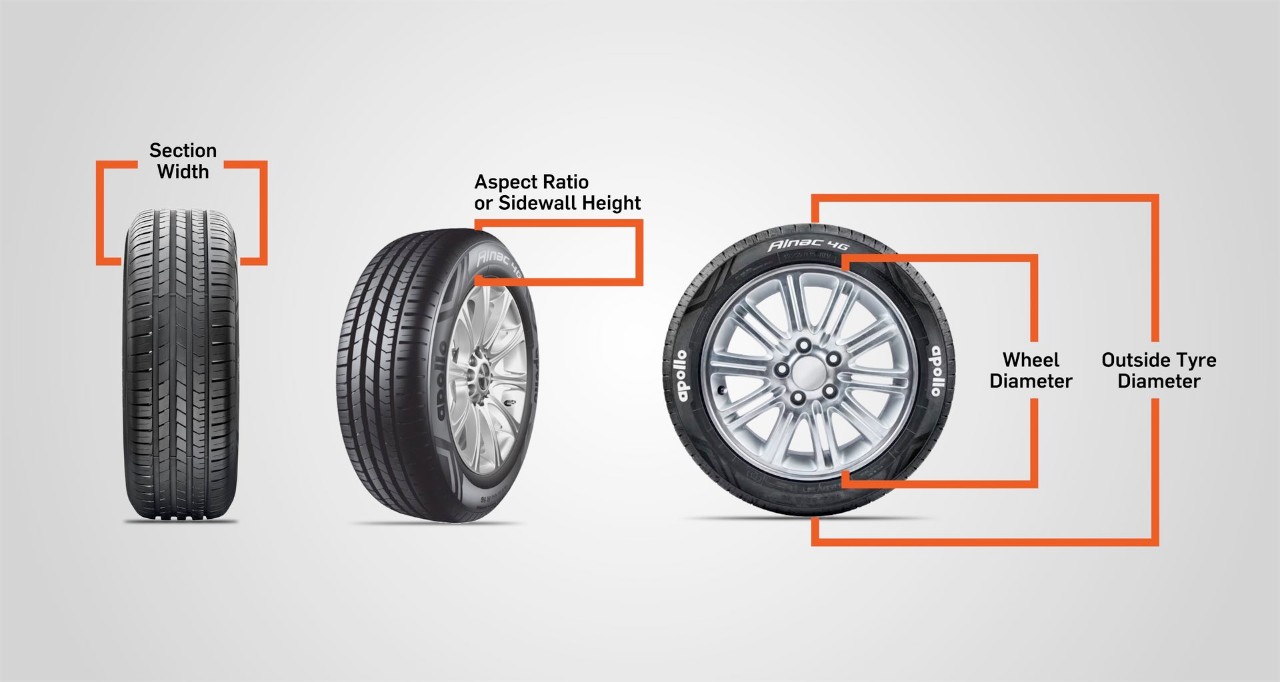You have no items in your shopping cart.
Upsizing your Tyres? Tips and Tricks
After buying a new car, the first things that most people upgrade are the wheels and tyres. There is no doubt they add visual pizzazz to your new pride and joy.
Tyre upsizing refers to the process of replacing a vehicle's original tires with larger tires. This involves increasing the tire's size in terms of its width, height, or both. The main purpose of upsizing tires is to improve the vehicle's handling, performance, appearance, and comfort.
However, it's important to note that upsizing tires may also have some disadvantages, such as decreased braking performance, altered speedometer readings, and potential compatibility issues with the vehicle's suspension and other components. It's recommended to consult a professional and verify if upsizing is compatible with your specific vehicle before making the change.
Read on or check out the Apollo Apterra Cross, if you are looking for upsizing hatchback or compact-SUV tyres 👇🏻
Types of tyre upsizing
There are two main types of tire upsizing:
Plus sizing: This involves increasing the wheel size while maintaining the same aspect ratio (the height of the tire relative to its width). This results in a larger tire with a shorter sidewall, providing improved handling and a sportier appearance.
Section width upsizing: This involves increasing the tire width while keeping the same wheel size. This results in a wider tire with a taller sidewall, providing a better ride and more stability.
It's important to note that upsizing tires can affect a vehicle's handling and performance, so it's recommended to consult a professional and verify if upsizing is compatible with your vehicle.

The art of upsizing your car tyres
Before you go for tyre upsizing, understand how it works. Many aftermarket shops will try and sell you the tyre and wheel that makes them the maximum profit. If you get the size wrong, not only the ride and handling of your car suffer, but it could also damage your car.
There is a reason that every manufacturer offers a standard size of tyre and wheel rim on a particular car. The wheel and tyre sizes are chosen to offer a balance between the performance dynamics, fuel efficiency, ride and handling. So, if you change from the standard size, one or all of these qualities will change.
For example, if you go for a larger diameter wheel, you will have to put a lower profile tyre on it. A lower profile tyre gives the car a certain élan, but the lower stiffer sidewalls completely change the driving dynamics of the car. If you have completely smooth tarmac, the car will handle if you are driving on rails. But on anything less than perfectly smooth roads, the ride will be super stiff and you’ll need an appointment with a chiropractor.
Check the right size and diameter of tyre
The first thing to remember is that there is not much scope to deviate from the total diameter of the tyre that comes originally fitted in your car without making drastic changes. To calculate the total diameter of the tyre, add the diameter of the wheel rim to the size of the sidewall. Here’s how you do it.
Read the marking on the side of the tyre. For example, it might read 175/70/R13. Now you know that 175 here refers to the size of the contact patch of the tyre in millimeters. The next figure 70 refers to the height of the sidewall in terms of percentage of the contact patch. R here means a radial tyre which is irrelevant for this. But the next figure 13 is the rim diameter in inches.
Let’s calculate the total tyre diameter:
17.5 cm + 70% of 17.5cm + 13 x 2.54 cm (1”= 2.54 cm)
Now do the math.
For a safe upgrade, the tyre size cannot be increased by more than three percent of the car’s original total tyre diameter. Any difference of more than three percent is just not recommended. The ideal maximum calculated upsize that can be done without upsetting the car’s dynamics is around three percent of the original total tyre diameter. Any increase above this will result in a noticeable drop in fuel efficiency and compromise ride and handling. It is best to go for an upgrade within the three percent margin for better performance and handling, increased grip and creating a visual appeal.
Check after tyre fitment
After you mount your new wheels on the car, sit behind the wheel and turn the steering from lock to lock. Turn the wheel in both directions. Check that on full lock the wheels are not touching the inside of the wheel well or any other part of the body.
Also, check that there is enough space between the tyre and the wheel well to any absorb bumps or potholes on the road. Go for a drive on an uneven or broken road to test that the bigger wheels and tyres are compromising the car’s ride quality.
Things which improve after upsizing tyres
The car’s aesthetics is point number one. Upsized wheels add appeal and enhance the look of your car. Wider tyre also provides more surface area for the car’s weight to be distributed on the ground, thereby increasing grip and traction. This results in a better drive and stability.
Things to watch for after upsizing tyres
Wider tyres have their downside as well. The wider tyres with more traction might reduce the car’s top speed. Acceleration might be affected due to the increase in weight and greater traction. This will affect the vehicle’s fuel economy. If you prefer lighter steering, think twice since you’ll need to put in more steering effort. Also, remember that your speedometer and odometer may not read correctly after upsizing.

Advantages of upsizing tyres
Upsizing tires can bring a number of advantages to a vehicle, including:
- Improved handling: Larger tires provide better traction and stability, especially at high speeds, making the vehicle more responsive and easier to control.
- Enhanced appearance: Upsizing tires can give a vehicle a sportier, more aggressive look, as well as improving its stance and overall appearance.
- Improved ride comfort: Wider tires with a taller sidewall can provide a smoother and more comfortable ride, as they absorb road shocks and vibrations better.
- Increased load capacity: Larger tires can support heavier loads, making them ideal for vehicles used for towing or carrying heavy loads.
- Improved fuel efficiency: Wider tires with a lower aspect ratio can reduce rolling resistance, which can result in improved fuel efficiency and lower emissions.
However, it's important to note that upsizing tires may also have some disadvantages, such as decreased braking performance, altered speedometer readings, and potential compatibility issues with the vehicle's suspension and other components. Therefore, it's important to consult with a professional and verify if upsizing is compatible with your specific vehicle.
Frequently asked questions:
Here we address some of the common queries people have when upsizing car or SUV tyres.
Can upsizing tyres reduce my car's mileage?
Yes, upsizing your tires can potentially reduce your vehicle's mileage. This is because larger tires will have a higher rolling resistance, which means more energy is required to turn them. As a result, your engine may have to work harder, which can lead to a decrease in fuel efficiency and therefore a reduction in mileage.
In addition, upsizing your tires can also affect your speedometer accuracy. If your speedometer is not recalibrated after upsizing, it may read a lower speed than your actual speed, which can cause you to unknowingly drive faster and consume more fuel.
Will increasing the wheel size increase ground clearance?
Increasing the wheel size alone will not increase ground clearance. Ground clearance is the distance between the lowest point of the vehicle and the ground. It is determined by various factors, such as the height of the suspension, the size of the tires, and the design of the vehicle.
While larger wheels may have taller tires, which can increase the overall diameter of the wheel and tire assembly, this alone will not necessarily increase the ground clearance. In fact, if the larger wheels are not paired with tires that have a higher profile or aspect ratio, the overall diameter may remain the same or even decrease, which can actually lower the ground clearance.
To increase ground clearance, modifications to the suspension system, such as lifting or raising the vehicle, may be necessary. It's important to note that modifying the suspension system can affect the handling and stability of the vehicle, and may require additional modifications to the braking system and other components.
Do larger tyres ride better?
Larger tires can provide a smoother ride under certain conditions, but this depends on various factors, such as the type of tires, the size of the wheels, and the driving conditions. One of the main benefits of larger tires is that they can absorb bumps and vibrations better than smaller tires. This is because larger tires have a greater air volume, which allows them to compress and flex more, providing a more comfortable ride.
In addition, larger tires can also improve handling and stability, particularly when driving on rough or uneven surfaces. This is because larger tires have a larger contact patch with the road, which provides more grip and traction, and can help to distribute the vehicle's weight more evenly.
However, larger tires can also have some drawbacks. They can be heavier than smaller tires, which can increase the unsprung weight of the vehicle and affect its handling and fuel efficiency. They can also be more expensive to purchase and replace than smaller tires.
Is it safe to upsize tyres?
Upsizing your tires can be safe, but it's important to ensure that the new tire size is compatible with your vehicle and that the tires are installed correctly.
Before upsizing your tires, you should check your vehicle manual or consult with a tire specialist to determine what tire sizes are recommended for your vehicle. You should also ensure that the new tire size does not exceed the maximum load and speed ratings of your vehicle and that it does not cause any clearance issues with the suspension or brakes.
Can upsizing tyres improve braking performance?
While larger tires can provide a wider contact patch with the road surface, which can potentially improve traction and grip, this alone is not likely to result in a significant improvement in braking performance. In fact, larger and heavier tires can actually increase the vehicle's unsprung weight, which can affect its handling and braking performance.
Can upsizing tyres improve fuel efficiency?
When you increase the size of your tires, the overall weight of the tire and wheel assembly increases, which can increase the unsprung weight of your vehicle. This can have a negative impact on your vehicle's fuel efficiency, as it can require more energy to move the heavier tires and wheels, particularly when accelerating or climbing hills.
